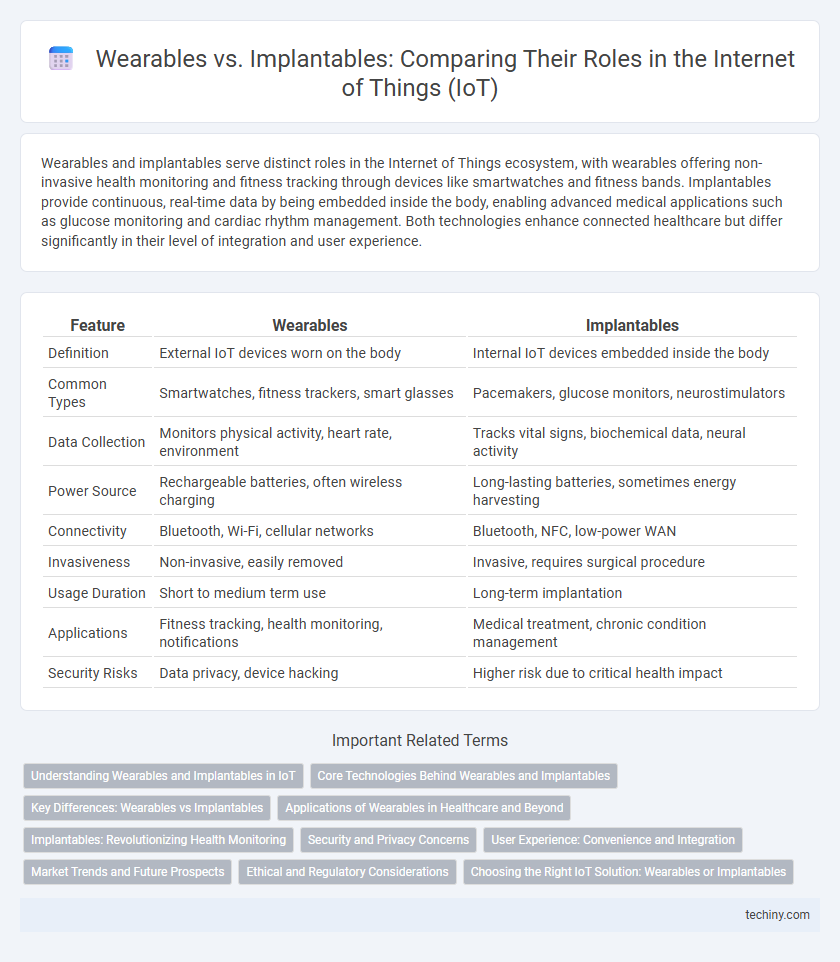Wearables and implantables serve distinct roles in the Internet of Things ecosystem, with wearables offering non-invasive health monitoring and fitness tracking through devices like smartwatches and fitness bands. Implantables provide continuous, real-time data by being embedded inside the body, enabling advanced medical applications such as glucose monitoring and cardiac rhythm management. Both technologies enhance connected healthcare but differ significantly in their level of integration and user experience.
Table of Comparison
| Feature | Wearables | Implantables |
|---|---|---|
| Definition | External IoT devices worn on the body | Internal IoT devices embedded inside the body |
| Common Types | Smartwatches, fitness trackers, smart glasses | Pacemakers, glucose monitors, neurostimulators |
| Data Collection | Monitors physical activity, heart rate, environment | Tracks vital signs, biochemical data, neural activity |
| Power Source | Rechargeable batteries, often wireless charging | Long-lasting batteries, sometimes energy harvesting |
| Connectivity | Bluetooth, Wi-Fi, cellular networks | Bluetooth, NFC, low-power WAN |
| Invasiveness | Non-invasive, easily removed | Invasive, requires surgical procedure |
| Usage Duration | Short to medium term use | Long-term implantation |
| Applications | Fitness tracking, health monitoring, notifications | Medical treatment, chronic condition management |
| Security Risks | Data privacy, device hacking | Higher risk due to critical health impact |
Understanding Wearables and Implantables in IoT
Wearables and implantables are two critical device categories in the Internet of Things ecosystem, enabling continuous health monitoring and seamless data collection. Wearables, such as smartwatches and fitness trackers, offer non-invasive tracking of physiological parameters, while implantables like pacemakers and glucose sensors provide direct internal monitoring with greater precision. Both device types rely on wireless connectivity, data analytics, and real-time feedback to enhance personalized healthcare and chronic disease management in IoT-enabled environments.
Core Technologies Behind Wearables and Implantables
Wearables and implantables rely on core technologies such as sensors, wireless communication modules, and embedded systems to collect and transmit health data. Advanced microelectromechanical systems (MEMS) and flexible electronics enable continuous monitoring in wearables, while biocompatible materials and energy harvesting methods are critical for implantables to ensure long-term functionality. Both device types leverage machine learning algorithms and cloud computing for real-time data analysis and personalized health insights.
Key Differences: Wearables vs Implantables
Wearables, such as smartwatches and fitness trackers, are external devices designed for monitoring health metrics and daily activities with easy removal and minimal invasiveness. Implantables, including pacemakers and glucose monitors, are surgically placed inside the body for continuous, real-time physiological data collection and medical intervention. Key differences lie in the level of invasiveness, continuous data accuracy, and long-term monitoring capabilities essential for critical health management.
Applications of Wearables in Healthcare and Beyond
Wearables in healthcare offer real-time monitoring of vital signs, enabling early detection of conditions such as arrhythmia and diabetes through continuous glucose monitoring. Beyond healthcare, wearables enhance fitness tracking, sleep analysis, and stress management, supporting personalized wellness routines and athletic performance optimization. The integration of wearables with IoT ecosystems facilitates seamless data sharing across devices, improving remote patient care and enabling smart home automation for health management.
Implantables: Revolutionizing Health Monitoring
Implantables revolutionize health monitoring by providing continuous, real-time data from inside the body, enabling precise tracking of vital signs and chronic conditions. Advanced sensors embedded under the skin monitor parameters such as glucose levels, heart rhythms, and intracranial pressure with unmatched accuracy. This seamless integration with IoT networks enhances personalized medicine and proactive healthcare management, reducing hospital visits and improving patient outcomes.
Security and Privacy Concerns
Wearables and implantables in the Internet of Things face distinct security and privacy challenges due to their differing levels of invasiveness and data sensitivity. Implantables often carry higher risks related to unauthorized access or hacking, potentially compromising critical health data and personal safety. Robust encryption protocols, continuous monitoring, and strict compliance with healthcare data regulations are essential to safeguard user information across both device categories.
User Experience: Convenience and Integration
Wearables offer user convenience through easy removal, charging, and customization, seamlessly integrating with smartphones and apps to provide real-time health data and notifications. Implantables deliver continuous monitoring and enhanced accuracy without user intervention, fostering a seamless integration with the body for uninterrupted data flow. Both prioritize user experience but differ in the balance between convenience, maintenance, and depth of health insights.
Market Trends and Future Prospects
Wearables currently dominate the Internet of Things market with a projected CAGR of 20.5% from 2023 to 2030, driven by demand for health and fitness tracking devices. Implantables, though smaller in market share, are expected to experience significant growth due to advancements in biomedical sensor technology and regulatory approvals for medical applications. Future prospects highlight increased integration of AI and IoT for personalized healthcare, enhancing the functionality and adoption of both wearables and implantables globally.
Ethical and Regulatory Considerations
Wearables and implantables in the Internet of Things ecosystem present distinct ethical and regulatory challenges, particularly regarding data privacy, informed consent, and long-term health impacts. Wearables often face fewer regulatory hurdles due to their non-invasive nature, while implantables require rigorous FDA approval and ongoing monitoring to ensure safety and efficacy. The integration of biometric data from implantables intensifies concerns about surveillance, data breaches, and the need for robust cybersecurity frameworks to protect users' rights and wellbeing.
Choosing the Right IoT Solution: Wearables or Implantables
Wearables like smartwatches and fitness trackers offer non-invasive health monitoring with ease of use and broad compatibility, making them ideal for general wellness tracking. Implantables provide continuous, precise data collection for critical medical conditions, leveraging IoT connectivity to enable real-time diagnostics and personalized treatments. Selecting the right IoT solution depends on specific health goals, required data accuracy, and user comfort, balancing convenience against invasiveness and technological capability.
Wearables vs Implantables Infographic

 techiny.com
techiny.com